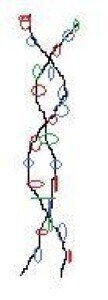News
New process can label DNA synthesis in vivo
Dec 13 2011
Scientists have identified a new substance which can aid the labelling and visualisation of DNA synthesis in vivo.
The team from the University of Zurich explained that to visualise the synthesis of biomolecules in living organisms, often referred to as in vivo, artificial small molecules can be added to cell's own biosynthetic machinery and then become incorporated.
According to the scientists, the artificial molecules can then be highlighted selectively with fluorescent substances, but until now all of these substances have been toxic and caused cell death.
Anne Neef, of the Institute of Organic Chemistry at the University of Zurich, created a new substance, called called F-ara-Edu, that can replace the naturally occuring nucleoside thymidine in DNA biosynthesis with little or no impact on the health of the cell.
"As a demonstration of this, F-ara-Edu was injected into Zebrafish eggs immediately after fertilization. Following development and hatching of the fish, the very first cells undergoing differentiation in embryonic development could be identified," explained research advisor Professor Nathan Luedtke.
Posted by Fiona Griffiths
Digital Edition
Lab Asia Dec 2025
December 2025
Chromatography Articles- Cutting-edge sample preparation tools help laboratories to stay ahead of the curveMass Spectrometry & Spectroscopy Articles- Unlocking the complexity of metabolomics: Pushi...
View all digital editions
Events
Jan 21 2026 Tokyo, Japan
Jan 28 2026 Tokyo, Japan
Jan 29 2026 New Delhi, India
Feb 07 2026 Boston, MA, USA
Asia Pharma Expo/Asia Lab Expo
Feb 12 2026 Dhaka, Bangladesh



















